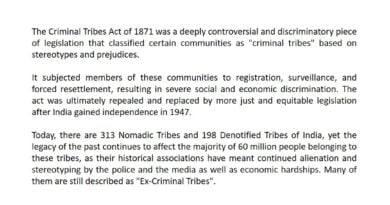Juvenile Justice Amendment Bill, 2021
Ministry: Law and Justice
Context:
Recently, the Juvenile Justice Amendment Bill (Care and Protection of Children), 2021, was passed in the Rajya Sabha.
- The bill seeks to amend the Juvenile Justice Act, 2015.
About:
- The Juvenile Justice (Care and Protection of Children) Amendment Bill, 2021 was introduced in Lok Sabha on March 15, 2021 and passed Rajya Sabha.
- The Bill amends the Juvenile Justice (Care and Protection of Children) Act, 2015. The Statement of Objects and Reasons of the 2021 Bill states that adoption cases have witnessed significant delay in courts. Further, it states that adoption cases are non-adversarial in nature and can be dealt through a well laid out process.
- A similar Bill empowering district magistrates to issue adoption orders was introduced in Lok Sabha in August 2018. However, the Bill lapsed with the dissolution of the 16th Lok Sabha.
- Under the 2015 Act offences committed by juveniles are categorized as: heinous offences (those with minimum punishment of seven years of imprisonment under IPC or any other law), serious offences (three to seven years of imprisonment), and petty offences (below three years of imprisonment). In 2020, the Supreme Court observed that the Act does not deal with offences where the maximum sentence is more than seven years of imprisonment, but there is no minimum sentence, or minimum sentence is of less than seven year The Court ordered that these offences should be categorized as serious offences. The Bill also seeks to give effect to this order.
Key Features of Juvenile Justice Amendment Bill
- Adoption: Under the Act, once prospective adoptive parents accept a child, an adoption agency files an application in a civil court to obtain the adoption order. The adoption order issued by the court establishes that the child belongs to the adoptive parents. The Bill provides that instead of the court, the district magistrate (including additional district magistrate) will perform these duties and issue all such orders.
- Appeals: The Bill provides that any person aggrieved by an adoption order passed by the district magistrate may file an appeal before the Divisional Commissioner, within 30 days of such order. Such appeals should be disposed within four weeks from the date of filing of the appeal.
- The Act provides that there will be no appeal for any order made by a Child Welfare Committee concluding that a person is not a child in need of care and protection. The Bill removes this provision.
- Serious offences: The Act provides that the Juvenile Justice Board will inquire about a child who is accused of a serious offence. Serious offences are those for which the punishment is imprisonment between three to seven years. The Bill adds that serious offences will also include offences for which maximum punishment is imprisonment of more than seven years, and minimum punishment is not prescribed or is less than seven years.
- Designated Court: The Act provides that offences against children that are punishable with imprisonment of more than seven years, will be tried in the Children’s Court (equivalent to a Sessions Court). Other offences (punishable with imprisonment of less than seven years) will be tried by a Judicial Magistrate. The Bill amends this to provide that all offences under the Act will be tried in the Children’s Court.
- Offences against children: The Act provides that an offence under the Act, which is punishable with imprisonment between three to seven years will be cognizable (where arrest is allowed without warrant) and non-bailable. The Bill provides that such offences will be non-cognizable and non-bailable.
- Child Welfare Committees (CWCs): The Act provides that states must constitute one or more CWCs for each district for dealing with children in need of care and protection. It provides certain criteria for the appointment of members to CWC. For instance, a member should be: (i) involved in health, education, or welfare of children for at least seven years, or (ii) a practising professional with a degree in child psychology, psychiatry, law, or social work. The Bill adds certain criteria for a person to be ineligible to be a member of the CWC. These include: (i) having any record of violation of human rights or child rights, or (ii) being a part of the management of a child care institution in a district.
Why amended needed
- The National Commission for Protection of Child Rights (NCPCR) audit of Child Care Institutions (CCIs) in 2020, 90% of which are run by NGOs, found that 39% CCIs were not registered, even after the 2015 amendment was brought in.
- It also found that less than 20% CCIs, especially for girls, had not been set up in some states, 26% child welfare officers were not there.
- Moreover, three-fifths have no toilets, one-tenth have no drinking water and 15% homes don’t have provisions of separate beds, no diet plans.
- Rehabilitation of children is not a priority for childcare homes and children are reportedly kept in such institutions to get funds.
KEY ISSUES AND ANALYSIS
- Empowering the district magistrate to issue adoption orders
- The Juvenile Justice (Care and Protection of Children) Act, 2015 states that adoption of a child is final once a civil court issues an adoption order The Bill amends this to provide for the district magistrate (including the additional district magistrate) to issue such adoption orders instead. Any person aggrieved by such an adoption order may file an appeal with the Divisional Commissioner. This may raise certain issues discussed below.
- Need for transferring power to issue adoption orders from courts to the district magistrate
- The Statement of Objects and Reasons (SOR) of the Bill states that there is significant delay in finalising adoption cases in courts. To expedite adoption proceedings, the Bill empowers the district magistrate to issue such orders.
- Between April 2015 and March 2020, about 19,000 children have been adopted, an average of 320 adoptions per month.
- As on July 2018, there were 629 adoption cases pending in various courts.
- The question is whether this constitutes a significant delay, and consequently requires shifting the power to issue adoption orders from the court to the district magistrate. Empowering district magistrates to issue adoption orders may also lead to delays as they are already burdened with several responsibilities such as maintenance of law and order, land and revenue administration, disaster management, general administration, and implementing government schemes and programmes in their district. A district magistrate chairs about 75 committees, spread across 23 departments.
- Lack of judicial scrutiny in adoption orders
- Under the Act, adoption of a child is final once a court issues an adoption order. With this, the child becomes the lawful child of his adoptive parents with all the rights, privileges, and responsibilities that are given to a biological child. The Bill shifts the power to issue adoption orders from the court to the district magistrate (including the additional district magistrate).
- The question is whether it is appropriate for an administrative authority to issue adoption orders instead of a judicial body.
- The SOR of the Bill states that adoption cases are non-adversarial in nature and can be dealt as per the process laid out.
- Further, the Bill provides that any person aggrieved by an adoption order, may file an appeal before the divisional commissioner. Thus, it does not provide for judicial oversight at the appeal stage as well.
- District magistrates and divisional commissioners are trained to be administrators and perform functions of the government. They may not have the competence to issue adoption orders or hear appeals related to them. Vesting of such core judicial functions with them may also raise concerns of separation of powers between the executive and the judiciary.
- Issues with implementation of the Act
- Various Courts and Standing Committees have noted issues with the implementation of the 2015 Act and have provided several recommendations.
- Lack of availability and limited capacity of institutions set up under the Act
- The 2015 Act provides for setting up one or more Juvenile Justice Boards (JJBs) and Child Welfare Committees (CWCs) in every district. The Standing Committee on Human Resource Development (2015) had noted that statutory bodies under the Juvenile Justice Act, 2000 including JJBs and CWCs were not present in many states.Several bodies existed only on paper, and were not functioning. Further, populous districts which were likely to produce larger caseloads had inadequate CWCs.
- The National Legal Services Authority (2019) noted that only 17 of 35 states/Union Territories (UTs) had all basic structures and bodies required under the Act in place
- Child-care institutions (CCIs): CCIs refer to institutions including open shelters and specialised adoption agencies, which provide care and protection to children in need of such services. As of March 2020, there were 2,162 CCIs across India. The Committee on review exercise of CCIs (2018) noted that many CCIs fail to provide even the basic services to the children including individual bedding, and proper nutrition and diet. In 2018, the Supreme Court recommended that state governments evaluate CCIs across India to ensure that minimum standards of care are being complied with. The Committee also noted that despite registration being mandatory under the 2015 Act, only 32% of total CCIs across the country were registered. The Supreme Court (2017) recommended that all children in CCIs be registered compulsorily and this data be verified and validated.
- Role of High Courts: In 2018, the Supreme Court requested that the Chief Justice of every High Court to register proceedings on its own motion to ensure effective implementation of the Act. In 2017, the Court had suggested that Juvenile Justice Committees should be set up in every district and should comprise of High Court judges, who have a constitutional obligation to protect the fundamental rights of children.
- Delays in Adoption
- The 2015 Act empowers Central Adoption Resource Authority (CARA) to regulate and promote adoptions in India. In 2017, the Madhya Pradesh High Court noted that children declared legally free for adoption were not being given timely referrals by CARA. The Court recommended that the Steering Committee of CARA may monitor and investigate the conduct of CARA. Further, action must be taken against individuals responsible for the delay.
- Juveniles in conflict with law
- Incidence of crime: Under the Indian Penal Code, 1860 (IPC), the minimum age at which any person can be charged for a crime is seven years. The total number of children arrested rose from 33,642 in 2009 to 38,685 in 2019, an increase of 15%. Children in the 16-18 years’ age group account for majority of children arrested. More than half of the children were arrested for offences such as theft, causing hurt, burglary, and riots.
- Pendency: Pendency of cases of juveniles in conflict with law has increased over the years from 43% in 2009 to 51% in 2019 (Figure 3). The total number of convictions decreased from 52% in 2009 to 43% in 2019, whereas acquittals remained below 10%.
Juvenile Justice (Care and Protection of Children) Act, 2015
- The Juvenile Justice (Care and Protection of Children) Act, 2015 replaced the Juvenile Justice (Care and Protection of Children) Act, 2000.
- Change in Nomenclature:
- The Act changes the nomenclature from ‘juvenile’ to ‘child’ or ‘child in conflict with law’. Also, it removes the negative connotation associated with the word “juvenile”.
- It also includes several new and clear definitions such as orphaned, abandoned and surrendered children; and petty, serious and heinous offences committed by children.
- Special Provisions for Age 16-18 years:
- Included special provisions to tackle child offenders committing heinous offences in the age group of 16-18 years.
- Mandatory Constitution of the JJ Board:
- It mandates setting up Juvenile Justice Boards and Child Welfare Committees in every district. Both must have at least one woman member each.
- Adoption Related Clauses:
- A separate new chapter on Adoption to streamline adoption procedures for an orphan, abandoned and surrendered children.
- Also, the Central Adoption Resource Authority (CARA) was granted the status of a statutory body to enable it to perform its function more effectively.
- The Act states that the adoption of a child is final on the issuance of an adoption order by the court. Currently, there are 629 adoption cases pending in various courts.
- Child Care Institutions (CCI):
- All Child Care Institutions, whether run by State Government or by voluntary or non-governmental organisations are to be mandatorily registered under the Act within 6 months from the date of commencement of the Act.
Source: PRS
You can find many articles on ACTS AND AMENDMENTS and JUDICIARY (part of GS II) in our website. Go through these articles share with your friends and post your views in comment section.



